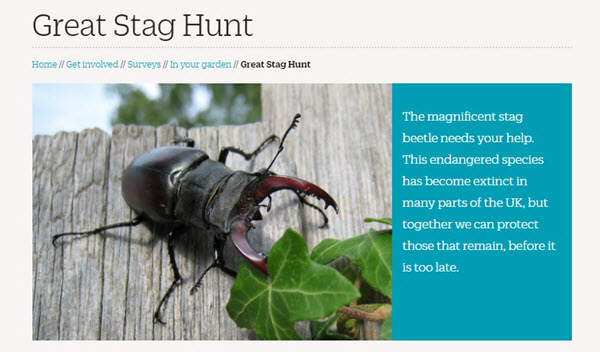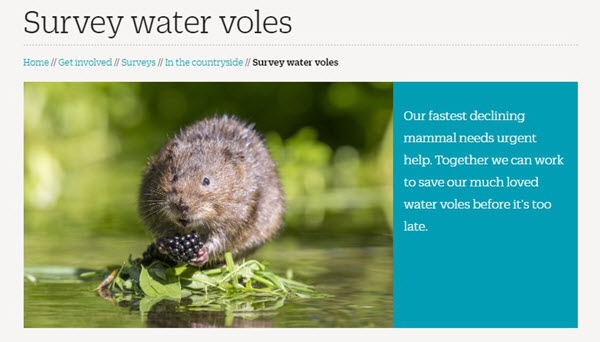The People’s Trust for Endangered Species is asking for our help in recording two species – the Stag Beetle and Water Vole.
Spotted a stag beetle? Help save the UK’s largest land beetle by recording your sightings
Like many British species, it is becoming rare to catch a glimpse of the formidable looking, but friendly stag beetle (Lucanus cervus). Sadly, their numbers are dwindling across Europe due to loss of habitat and predators including cats, magpies and humans. In parts of Britain stag beetles are already extinct, so help is needed to prevent further decline. This spring, People’s Trust for Endangered Species (PTES) is asking the public to record any sightings of these iconic insects by taking part in their annual Great Stag Hunt.
Stag beetles emerge from mid-May onwards, and live in gardens, parks, woodland edges and traditional orchards. Stag beetles are prevalent throughout southern England and coastal areas of the south west, while they are less common in the north of England and the South Downs. PTES also wants to hear from people living in areas that border the stag beetles’ known range, such as Devon, Norfolk, Worcestershire and Yorkshire.
Stag beetles can reach up to 75mm in size, which makes them second largest of all UK beetles after the water beetle, but also easy to spot! For the majority of their life cycle, stag beetles remain underground as larvae, feeding on rotten wood. They can remain as larvae for as long as 7 years, and once fully grown they build a large cocoon in the soil where they pupate before finally metamorphosing into their adult, more recognisable, form.
Last year’s Great Stag Hunt saw 5,796 recorded stag beetle sightings, including 901 sightings in Hampshire alone. There are no set rules for the Great Stag Hunt, just simply record any sightings of stag beetles online, which will help PTES’ wider conservation strategy. You will also find advice on how to identify a stag beetle, find out what to do if you find a stag beetle or dig up stag beetle larva.
You can see the distribution of Stag Beetles on the NBN Gateway
Save our riverside residents: volunteers required to help combat declining UK water vole populations
Last year, People’s Trust for Endangered Species launched the first ever National Water Vole Monitoring Programme (NWVMP). After a successful initial year, PTES is hoping to build on this citizen science project with a call for more volunteers to participate this May. Water voles were once a common sight along UK riverbanks and waterways, but over the last century they have experienced the most severe decline of any wild mammal in the UK. The NWVMP provides an essential resource in our efforts to conserve the species.
The decline in water vole populations has been attributed to the intensification of agriculture in the 1940s and 50s, and more recently the release of non-native American mink during the 1980s and 90s. The impact of mink has been devastating: between 1989-1998 the water vole population crashed by almost 90%.
The first year of the NWVMP saw 188 waterway sites surveyed by volunteers, of which 68 indicated water voles were present. While this is a great start, PTES is still looking for more volunteers to help survey sites across the UK, to ensure all regions have a sufficient number of sites being surveyed. In particular more sites are needed in the South-West, East and North of England, Wales and Northern Scotland. Once a site is surveyed the data are submitted online, allowing PTES to develop a wider picture of how UK water voles are faring, and of which populations are in most need of help.
This spring, PTES is asking existing water vole monitors, and new recruits, to take part in the 2016 NWVMP. Volunteers are required to survey one of the nearly 900 pre-selected sites across England, Wales and Scotland, and record all sightings and signs of water voles along a 500m length of riverbank during May. While no experience is required, those taking part will need to learn how to identify water vole field signs.
Emily Thomas, who coordinates the NWVMP at PTES says: “We are delighted by the response to our first National Water Vole Monitoring Programme. With the help of volunteers we have started building a robust dataset that can be used to monitor year on year trends in the water vole population. The data gathered so far are invaluable, but more still needs to be done if we are to be in a position to act quickly to future changes and make a real impact to water vole conservation.”
To find out more or to take part in the 2016 National Water Vole Monitoring Programme, simply visit the website.
You can see the distribution of Water Voles on the NBN Gateway

